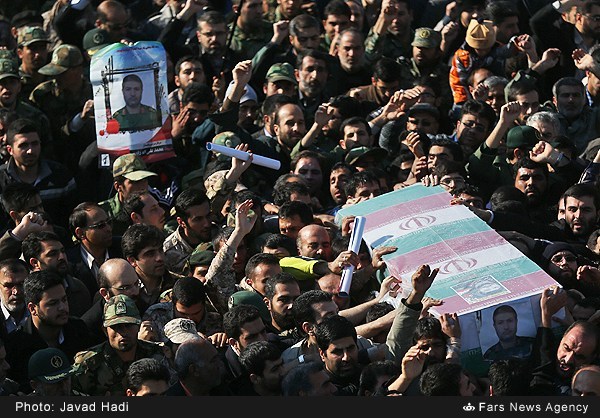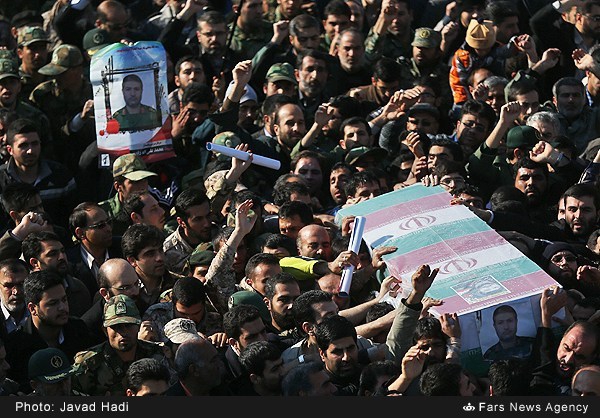 Funeral procession of Iranian Gen. Mohammad Ali Allahdadii[/caption]
Funeral procession of Iranian Gen. Mohammad Ali Allahdadii[/caption]Gen. Mohammad Ali Allahdadi of Iran's Revolutionary Guard, who died on Syria's Golan Heights Sunday alongside senior Hezbollah fighters, was buried Wednesday in Tehran. Israel has not officially commented on the incident.
TEHRAN ��Amid a wave of prayers and vengeful rhetoric toward�Israel,Iran�on Wednesday buried an army general killed in a presumed Israeli airstrike alongside six senior�Hezbollah�members in southern�Syria.
Iranians have grown used to burying �martyrs� of the�Islamic Revolutionary Guard Corps�(IRGC) who have died fighting Sunni militants in Syria.
But as hundreds of uniformed Guard officers reached out to touch and carry the coffin of Gen. Mohammad Ali Allahdadi � with sprays of rosewater flashing through�Tehran�s chill morning air � it was clear this death was different.
�This is our first martyred commander, who was killed directly with a Zionist bullet,� said the master of ceremonies in a prayer hall just inside the gate of an expansive IRGC base in eastern Tehran.
The IRGC commander,�Maj. Gen. Mohammad Ali Jafari, warned Tuesday that Israel faced �imminent collapse� and �should expect devastating thunderbolts; they have seen our anger in the past.�
He also said the fact that a senior Iranian officer was killed alongside Lebanon-based Hezbollah fighters, on a joint mission in theGolan Heights�close to Israel�s border, �showed that the Islamic revolution has bypassed geographical borders and a unified Islamic front is established.�
Axis of resistance
Iran has long declared itself leader of an axis of resistance � along with Hezbollah, Syria, and Palestinian militant groups Hamas and Islamic Jihad � against�US�and Israeli influence in the region.
Iran and Hezbollah have deepened their role in Syria over the last two years on behalf of President Bashar al-Assad. The US, Turkey, and several Sunni Arab nations have backed anti-Assad rebels.
As Gen. Allahdadi�s coffin lay nearby, Maj. Gen. Jafari said Wednesday that �the combination of Quneitra martyrs is a promising sign of victory in [Jerusalem].� We hope that the shameful Zionist stain in Muslim regions would soon be removed.�
Banners glorified Allahdadi�s status as a martyr, wreathed in symbolic iconography of Shiite imams and their ideology of resistance. Depicted were white doves trailing red ribbons, and painted splatters of blood.
Also killed in Sunday�s attack was Jihad Mughniyeh, son of Imad Mughniyeh, a former Hezbollah military commander believed to have been assassinated by Israel in Damascus in 2008. In a sign of close ties, the office of Iran�s supreme leader,�Ayatollah Ali Khamenei, posted photographs of Mr. Khamenei embracing Jihad Mughniyeh.
UN-patrolled buffer zone
An IRGC statement said the group was �inspecting the region of Quneitra� and that Allahdadi �had traveled to the region as an adviser� to help Syria fight Sunni militant �terrorists,� according to Tasnim News Agency. The abandoned and mostly destroyed city of Quneitra lies in a UN-patrolled buffer zone between Israeli and Syrian forces on the Golan Heights.
In his eulogy, Jafari said Allahdadi had devoted his life to the IRGC, first during the Iran-Iraq War of the 1980s, and later commanding different brigades.
�In his last years before retirement � Allahdadi eagerly accepted the [IRGC�s elite] Qods Force offer and was dispatched to Lebanon and Syria.� Allahdadi should serve as a �model� for other Iranian officers by earning a �special place in the eyes of God� through jihad and martyrdom, Jafari said.
�Israel will pay dearly for this, [it] will face a terrible end,� said a Revolutionary Guard official after the funeral. �What would you do if one of your generals were killed by another country?�
By The Christian Science Monitor
The Iran Project is not responsible for the content of quoted articles.











